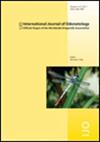条纹交尾虫和秃头交尾虫(鸟纲:蝶形目)在咸水中的发育情况
IF 1
4区 农林科学
Q3 ENTOMOLOGY
引用次数: 0
摘要
S. vulgatum (Linnaeus, 1758)和S. striolatum (Charpentier, 1840)是两种在中欧广泛分布和常见的近缘鳞虾科(Libellulidae)。这项研究的想法源于通常使用盐水虾饲养幼体、观察到的在海水中产卵的交杯虫物种以及 S. striolatum 在咸水生境中的定殖能力。由于未来气候变化或人为活动,淡水盐碱化可能会加剧,因此这一课题对蜻蜓种群的意义也将日益重大。本研究中的实验旨在了解这两种蜻蜓的卵和幼虫能否在咸水中发育。为此,将这两种鱼的卵保存在 0.5-1.5% 的四种不同盐度条件下,记录发育持续时间、孵化曲线、生长率和死亡率,并与之前在自来水中进行的实验的相关数据进行比较。与在淡水中饲养相比,不同盐度是否会影响胚胎发育、孵化行为和幼虫生长。我们发现,这两个物种的卵都能在不同盐浓度(最高达 1.5%)下发育,幼虫也能在咸水中存活和生长。特别是对 S. striolatum 而言,与在自来水中饲养相比,略微提高盐度似乎更有利,因为孵化率和存活率都很高。这项研究的结果增加了盐对这两种鱼类影响的一些知识。低浓度盐似乎对两种鱼类都有很好的耐受性,甚至对横纹短尾鳕有利。此外,研究结果还提供了饲养蜻蜓幼虫的方法。本文章由计算机程序翻译,如有差异,请以英文原文为准。
Development of Sympetrum striolatum and S. vulgatum (Odonata: Libellulidae) in brackish water
Sympetrum striolatum (Charpentier, 1840) and S. vulgatum (Linnaeus, 1758) are two closely related Libellulidae that are widespread and common in Central Europe. The idea for this research originates from normally using saltwater shrimps for rearing young larvae, the observations of Sympetrum species laying eggs in seawater and the suggested ability of S. striolatum to colonize brackish water habitats. This topic will also be of rising relevance for dragonfly populations as in the future due to climatic changes or anthropogenic activity the salinization of freshwaters will likely increase. The experiments presented in this study served to find out whether eggs and larvae of both species can develop in brackish water. For this purpose, eggs of both species were kept at four different salinities from 0.5–1.5% and the development duration, hatching curves and growth rates as well as mortality were recorded and compared to respective data from an earlier experiment conducted in tap water. It was possible to investigate whether embryonic development, the hatching behaviour and larval growth are disturbed by different salinity levels compared to rearing in freshwater. We found for both species that the eggs can develop at different salt concentrations up to 1.5% and the larvae survive and grow in the brackish water. Especially for S. striolatum a slightly increased salinity even seems to be advantageous compared to rearing in tap water shown by high hatching and survival rates. The results of this study add some knowledge about the influencing effects of salt on both species. It seems that low salt concentrations seem to be well tolerated by both species or become even beneficial for S. striolatum. Furthermore, the results provide methodological aspects about the rearing of young dragonfly larvae.
求助全文
通过发布文献求助,成功后即可免费获取论文全文。
去求助
来源期刊

International Journal of Odonatology
ENTOMOLOGY-
CiteScore
2.30
自引率
0.00%
发文量
15
审稿时长
>12 weeks
期刊介绍:
International Journal of Odonatology (IJO) is aimed at providing a publication outlet for the growing number of students of Odonata. It will address subjects such as the ecology, ethology, physiology, genetics, taxonomy, phylogeny and geographic distribution of species. Reviews will be by invitation, but authors who plan to write a review on a subject of interest to the journal are encouraged to contact the editor.
 求助内容:
求助内容: 应助结果提醒方式:
应助结果提醒方式:


